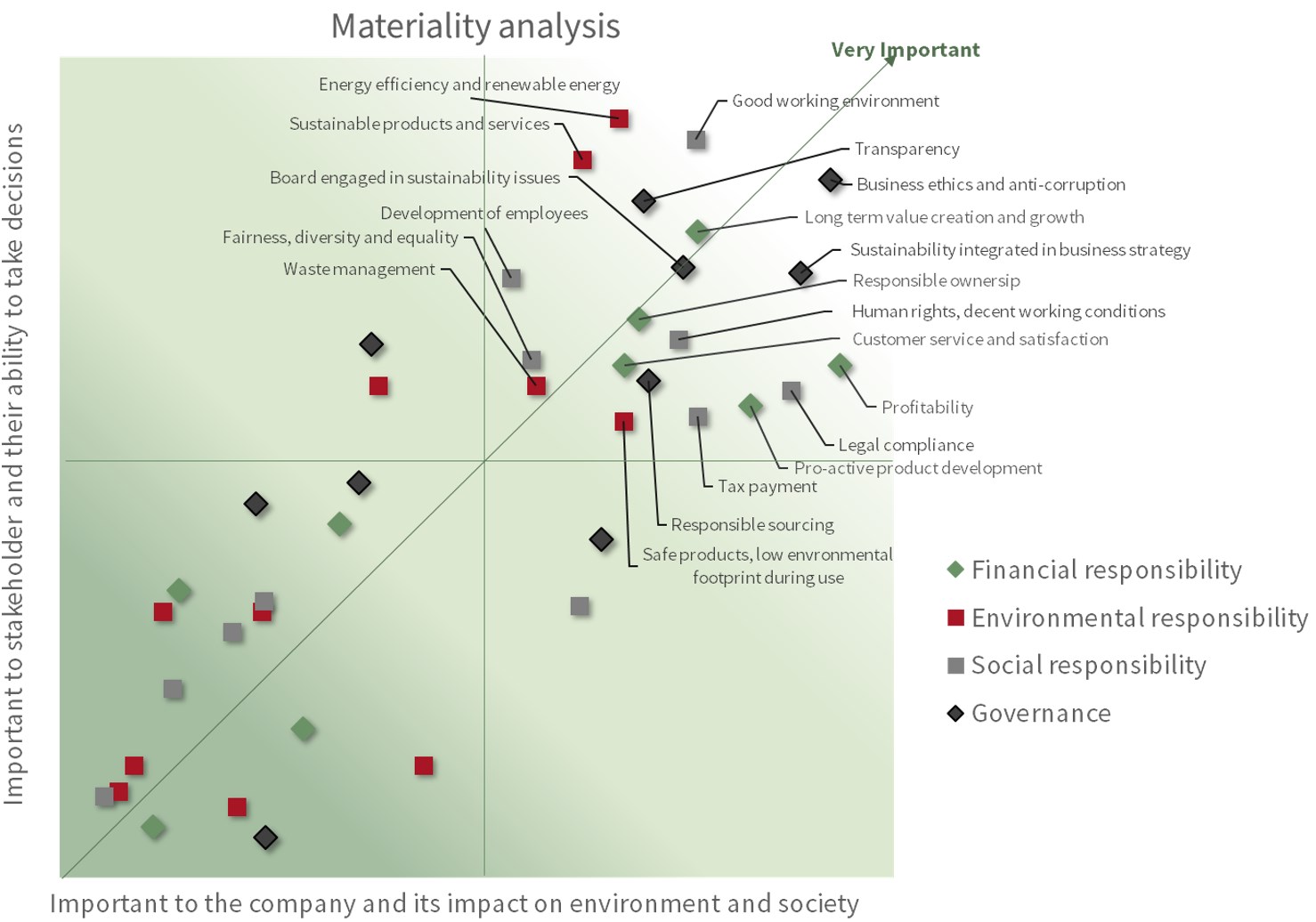GRI-Appendix
Material aspects and boundaries
G4-17 - Operational structure of the organisation
Web reference www.nibe.com/nibe-group
G4-18 - Process for defining report content
Reference AR 24-25 Pdf, 8.4 MB.» Pdf, 8.4 MB.
- Step 1: Identification
Relevant topics have been identified by looking at the different types of impact that occur in each step of our value chain. We have considered our products, market and supply chain, as well as our vision and mission in view of what needs be improved in order to support sustainable development. We have considered the impact outside the organisation and in the interfaces between the organisation and external parties, combined with what topics and concerns our stakeholders historically have raised. This gave us a gross list of possibly material topics that needed prioritisation. - Step 2: Prioritisation
We used the list of identified topics as a basis for our stakeholder dialogue and for our internal discussions. All the topics were rated from the most important to the least important. From the list of rated topics, we have chosen to focus on the top 15-20 ones that have been considered as most important both by our external and by our group management team. - Step 3: Validation
We have analysed the outcome of step 1 and 2, and found that the prioritised topics represent a balanced combination that includes several angles of our economic, environmental and social responsbility. These topics might change over time, as our business developes and stakeholder demands changes.
G4-19 - List all the material aspects identified
Reference AR 24 Pdf, 8.4 MB.» Pdf, 8.4 MB.
Materiality analysis
NIBE's working group for sustainability issues together with Group management carried out a materiality analysis based on the areas that are regarded as most relevant to the company's operational focus and geographical presence as well as international initiatives such as the Global Compact and Agenda 2030 (SDG). The assessment also included business environment requirements, global trends, standards (GRI, ISO 14001 and CDP), the Company’s expected future growth, with the concomitant risks and opportunities, and the outcome of the dialogue with stakeholders.
The top priority aspects are summarised in the diagram below.

If we compare NIBE’s current work in the areas identified as priorities in the materiality analysis, it sits well with the choices and priorities made by NIBE to date:
- NIBE’s products support the transition to sustainable cities and infrastructure. The product range is largely based on energy efficiency enhancement and renewable energy and is therefore in line with climate-adapted products as a business strategy.
- NIBE invests in energy efficiency enhancement and renewables in its own operations and has measurable targets for this.
- The decision to sign the Global Compact reinforced NIBE’s previously communicated values to respect human rights and take responsibility for the natural environment, working environment and ethical business methods.
- NIBE has an accident rate target to create a safe working environment.
- NIBE has responded to the need to train its staff. In the last two years, we have implemented extensive training initiatives in ethical business and anti-corruption, primarily for those who have external contacts.
In line with its operational priorities and where it was considered possible to exert influence, NIBE has chosen to prioritise six of the seventeen goals included in Agenda 2030:
See Annual report page 25.
In working on the materiality analysis, we identified many areas, in addition to those in which we already work, which require further work.
- A policy for anti-discrimination, diversity and gender equality will be drawn up. The work of subsidiaries will be evaluated against the policy and national legislation in connection with site visits.
- The focus on sustainability in the governance process will be increased by sustainability issues being communicated to the Group Board of Directors to a greater degree. Our annual GRI report will be signed by the Board of Directors, and sustainability will be integrated in our financial reporting.
The working environment will be an agenda item at subsidiaries’ board meetings at least twice a year, with accidents and actions being reported. All companies with more than 15 employees and an accident rate of more than 10 accidents per million hours worked will be required to prepare a written action plan for how they will achieve the target of an accident rate lower than 6 before the end of 2018. The plan will be evaluated and approved by the Group’s working group for sustainability issues, the ‘Sustainability Council’. (See page 101 of the Corporate Governance Report ).
In 2017, there will be a review of existing targets and ratios, based on the achievement of targets in 2016.
G4-20 - Report the Aspect Boundary of each material aspect.
Concerning limiting and reporting of environmental impact during the manufacturing and distribution phases of our products, we have included our production facilities (see table with production companies). Sales offices are included only in the reporting of energy use and carbon dioxide emissions (see list of sales offices included).
Concerning healthy and safe work environment, all companies within the NIBE Group, production and sales offices alike, report injuries and sick leave. The aspect is material primarily within the organisation (see complete list of companies in Annual report, page 88, 89).
For other aspect boundaries, see each aspect.
The Aspect Boundary within the organisation
See each aspect.
G4-21 - The Aspect Boundary outside the organisation
See each aspect.
G4-22 - Explanation of the effect of any re-statements
No significant re-statements
G4-23 - Significant changes from previous reporting periods in the Scope and Aspect Boundaries
No significant changes
